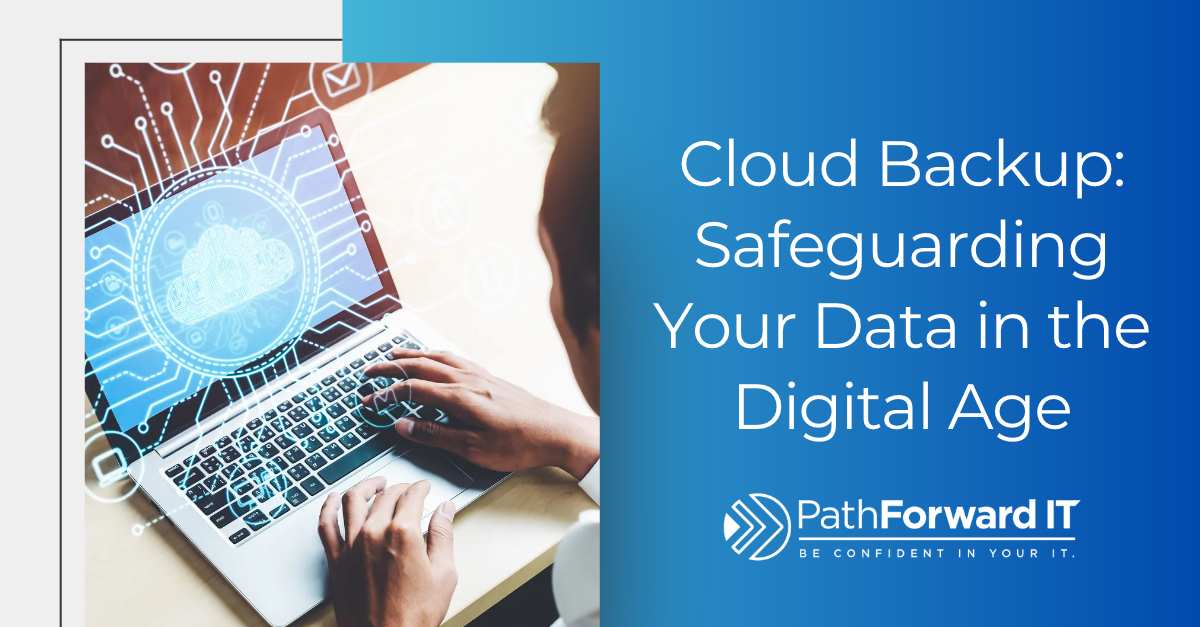Tag: Data Protection
Cloud Backup: Safeguarding Your Data in the Digital Age

In today’s technology-driven world, businesses and individuals rely heavily on data.
From critical business documents to cherished memories captured in photos and videos, the value of data cannot be overstated. However, data loss is a real and constant threat, whether due to hardware failures, natural disasters, or cyberattacks.
This is where cloud backup comes to the rescue. Cloud backup is a useful tool with many benefits. However, it can also present challenges. Here, we will discuss what cloud backup is, its advantages, and the difficulties it poses. Additionally, we will provide a list of best practices to ensure a successful cloud backup strategy.
Let’s first start by discussing exactly what cloud backup is.
Cloud backup is the process of securely storing data in a remote location hosted by a service provider. It involves transmitting data over the internet to the provider’s servers, where it is encrypted and stored for safekeeping. Cloud backup ensures that data remains accessible even if the original source is compromised.

Benefits of Cloud Backup:
1. Data Protection and Disaster Recovery: Cloud backup offers a robust solution for safeguarding your data. By storing it off-site in multiple redundant servers, it provides protection against hardware failures, theft, natural disasters, or other catastrophic events. In a survey by IDG, it was found that 90% of organizations use cloud services for data backup, and 53% of respondents stated that their primary use case for the cloud is data backup and recovery. (Source: IDG)
2. Easy Scalability: Cloud backup services are designed to accommodate growing data needs. Whether you need to store a few gigabytes or several terabytes, you can easily scale your storage space without the hassle of purchasing and managing additional hardware.
3. Accessibility: Cloud backup enables you to access your data from anywhere as long as you have an internet connection. This accessibility is particularly beneficial for businesses with remote teams or individuals who travel frequently.
4. Cost Efficiency: Cloud backup eliminates the need for investing in expensive hardware infrastructure and maintenance costs. Service providers typically offer flexible pricing models, allowing you to pay only for the storage space you use.
5. Automated Backup: Cloud backup solutions often provide automated backup processes, reducing the risk of human error. This ensures that data is consistently and regularly backed up without manual intervention.
Challenges of Cloud Backup:
1. Bandwidth Limitations: Uploading large amounts of data to the cloud can be time-consuming, especially if your internet connection has limited upload speeds. Initial backups may require significant time and resources, but subsequent incremental backups are generally faster.
2. Security and Privacy Concerns: While cloud backup services prioritize data security, concerns about unauthorized access, data breaches, or government surveillance may deter some individuals and organizations from embracing cloud backup. Selecting reputable providers with robust security measures and encryption protocols can alleviate these concerns.
In a survey by Barracuda Networks, 44% of respondents cited security and data privacy concerns as the primary reason for not adopting cloud backup. (Source: Barracuda Networks)
3. Dependence on Internet Connectivity: Cloud backup relies on a stable and reliable internet connection. If your connection is unreliable or experiences downtime, accessing and uploading data to the cloud may be disrupted.
4. Cost Considerations: While cloud backup can be cost-effective for many, organizations with substantial data storage needs may incur higher costs over time. It is essential to carefully evaluate pricing models, including storage tiers and data transfer fees, to ensure the chosen solution aligns with your budget.
Best Practices for Cloud Backup:
1. Define Backup Strategy: Determine what data needs to be backed up, how frequently, and the retention period. Categorize data based on importance to prioritize resources effectively.
2. Select a Reliable Provider: Research and choose a reputable cloud backup provider that aligns with your security requirements. Ensure the provider offers encryption, redundancy, and compliance with data protection regulations.
3. Encryption and Data Security: Encrypt data before transmission and choose a provider that offers encryption at rest. Implement strong access controls, two-factor authentication, and regular security audits.
4. Test and Validate Backups: Regularly perform test restores to verify the integrity and availability of your backup data. This practice ensures that your backup system is functioning correctly and that your data can be restored successfully if needed.
5. Implement Versioning and Retention Policies: Enable versioning to store multiple versions of files, allowing you to recover from accidental deletions or modifications. Establish retention policies to determine how long backups are retained based on regulatory requirements and business needs.
6. Monitor and Track Backup Activity: Set up monitoring and reporting mechanisms to track backup activities, including successful backups, failures, and completion times. Regularly review logs and alerts to identify and address any issues promptly.
7. Maintain Off-Site Copies: While cloud backup provides off-site storage, it’s prudent to maintain additional copies of critical data in alternative physical locations or with a secondary backup provider. This redundancy mitigates the risk of data loss in case of a catastrophic event.
8. Regularly Update and Test Recovery Procedures: Backup alone is not enough; ensure your recovery processes are up to date and well-documented. Regularly test your recovery procedures to validate their effectiveness and identify any potential gaps or weaknesses.
9. Educate and Train Users: Promote data backup awareness and provide training to users about the importance of backing up their data. Encourage good data hygiene practices, such as saving files in designated backup folders, to ensure comprehensive data protection.
10. Review and Update Backup Strategy: Regularly evaluate and update your backup strategy to accommodate changing data requirements, business growth, and emerging technologies. Stay informed about advancements in cloud backup solutions to take advantage of new features and improvements.
Cloud backup offers a reliable and efficient way to protect your valuable data from various risks and ensure its availability in the face of unforeseen events. By understanding the benefits, challenges, and best practices associated with cloud backup, individuals and businesses can implement a robust backup strategy that safeguards their data and provides peace of mind.
Embracing cloud backup empowers you to focus on your core activities, knowing that your data is secure and can be restored whenever needed.
Back Up Your Data to Get It Back From A Cyber Attack

Today’s accelerated technology trends are powering unprecedented business transformation. But they’re also introducing an overwhelming amount of security risk. Hackers use a wide range of tools and methods to gain access to your data—from social engineering and phishing scams to ransomware attacks and exploiting systems vulnerabilities. With virtually all personal and business data stored on internet-connected platforms, targeting businesses has become a gold mine for bad actors. To ensure the best chance of business continuity following any compromising cyber event, strategically backing up your data is one of the most foundational best practices you should include in your layered security checklist.
Business-Critical Backup and Recovery, Without A Plan
Cybersecurity professionals agree pretty much universally that, it’s not a matter of whether businesses will encounter an attack, but when. Trying to execute every-day business functions, without access to data, is like trying to drive a car without the tires—basically, inoperable. The very purpose of an holistic security strategy is to minimize as many gateways available to threat vectors as possible; local (on-prem locations), geographical distribution (networked systems) and cloud backups (primary or redundant data storage) are fundamental first steps in a layered approach to protecting your data.
Unfortunately, employing a data backup strategy isn’t as universally agreed upon. If that sounds contradictory, well, it is. In fact, even many IT professionals generally view backups as an insurance against the potential for an attack verses a priority to combat attacks. But consider this common scenario: a company has recognized the importance of backing up data and engages IT to deploy it. A random device is selected and turned on in a single location, but never tested, runs on subpar hardware, and has no particular defined parameters. This approach has a very different outcome during recovery from a cyber attack than a strategic data backup solution.
Business Continuity Predicated on Data Recovery
If you’re employing a set-it-and-forget-it backup strategy, you’re in for a rude awakening when an incident occurs. Waiting until you need your backups is, arguably, the worst time to wonder how many copies of your data are available and where and how they’re stored. During an incident, time is critical; downtime adds up quickly and can be extremely costly to your customers, your reputation, and your bottom line. Some businesses simply can’t recover; they go out of business. For a significant outage, you need to be able to act fast and be responsive. If you, or your solution provider don’t know what you don’t have, you’re looking at a substantial amount of downtime, and mounting associated recovery costs, as you work it out.
Making Cybersecurity A Priority with Data Backup
Companies are best positioned to assure business continuity if each of these steps have preceded an incident:
- Security-minded culture: user behaviors and policies awareness; ongoing compliance reinforcement
- Preventative measures: annual third-party security assessment to document vulnerabilities in the security controls, along with correction recommendations; firewalls and backup strategy functioning as intended; allow listings and access controls implemented; timely patching; audits, testing, monitoring, and spot checks; and fire drills to ensure everything is documented and security settings haven’t changed
- On-call service in place: 24/7/365 fully-staffed, live helpdesk of experienced, certified engineers with a 15-minute disaster response time
Off-loading some of the routine tasks associated with cyber hygiene like software updates, patching, testing, and backups to an MSP like Path Forward IT is an investment in your overall security plan. This simple step enables a service provider, with end-to-end data protection solutions, to get to know your systems environment intimately, enabling expert counsel for when you need to make operational changes that impact IT, are thinking about a purchase decision, or encounter an attack or natural disaster.
Backup Options Matter
Of course, you never want to get to recovery mode, but when you do, the quality of your backups will be very important. The best mitigation for destructive cyber-attacks is having rock-solid backups. However, with the advent of affiliate ransomware, attackers will now go after any accessible backups too. This makes a secure cloud-based backup solution a good choice—one that uses authentication that requires a unique set of complex credentials for access (does not overlap with workstation, server, or domain credentials) and does not require physical servers in the event of a disaster. What makes Cohesity enterprise-class backup solutions the preferred choice of so many enterprises worldwide are the expanse of options available to prepare your organization for a variety of data compromises. Cohesity provides a secondary repository with immutability, for offsite storage, ransomware early detection, and other advanced security features, along with a team behind it, monitoring and testing everything daily to ensure its efficacy.
The benefits of backup options become crystallized during a recovery operation. Customized data protection and recovery solutions provider, Path Forward IT, points to less production impact and downtime in general, rapid speed to restore, massive data storage of up to 35 PiB (pebibytes), granularity, and the flexibility to scale and customize the solution to fit customer needs.
Backup As Last Line of Defense
A layered security strategy improves your chances of stopping threats from penetrating your environment. But as new technologies develop and threat actors mature in finding ways to exploit them, strategically backing up your data can mean the difference between business devastation and a quickly-contained service interruption.
“If you put a key under the mat for the cops, a burglar can find it, too. Criminals are using every technology tool at their disposal to hack into people’s accounts. If they know there’s a key hidden somewhere, they won’t stop until they find it.”—Tim Cook, CEO, Apple Inc.
To learn more, request a consultation with Path Forward IT.
—

